Media | Articles
Revology Loses Its License from Ford, but Its Mustang Business Is Growing
Ten years ago this month, Revology, the Orlando-based builder of all-new cars that look like vintage Ford Mustangs, made its debut by displaying one at the Amelia Island Concours d’Elegance.
Even without driving it, multiple publications, ranging from Esquire to Top Gear to Hemmings, praised the $122,000 reimagined 1966 Mustang convertible on display. Most all were positive, some downright giddy: Jalopnik said, “Revology shocked the world by unveiling their hand-built restomod 1960s Ford Mustang.”
Some of the reader comments on those stories weren’t so kind. “$120K for this Meh-stang? No thanks,” wrote one.

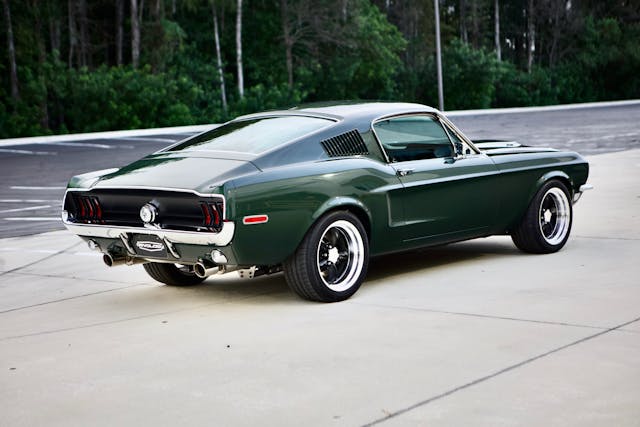

Now, 10 years later, the least expensive new Mustang on Revology’s price list is the1967 GT/GTA fastback, starting at $283,000.
Resale value on these cars is strong, too: Had you bought a $122,000 Revology Mustang convertible in 2015, you likely could have driven it for a decade and sold it now for what you paid.
Marketplace
Buy and sell classics with confidence
Company founder Tom Scarpello—who spent 17 years at Ford, including a stint as the leader of its Special Vehicle Team, back when SVT was building some memorable high-performance Mustangs—rankles at describing his cars as “replicas” or “restomods,” though neither are technically incorrect. He prefers the term “reproduction,” one reason being that Revology had something that other shops didn’t: A license from Ford to build new reproduction cars.
And now, they don’t. On the Frequently Asked Questions page of the company website, this is their explanation: “Revology Cars was licensed by Ford to build new reproduction Mustang rolling chassis from 2015 to 2024. Due a policy change at Ford, Revology is no longer permitted to build licensed reproduction Mustang rolling chassis. However, Revology continues to work closely with Ford on other projects. ” Revology still has a license from Shelby American, one of four companies Shelby has licensed to build reproduction Shelby GTs.
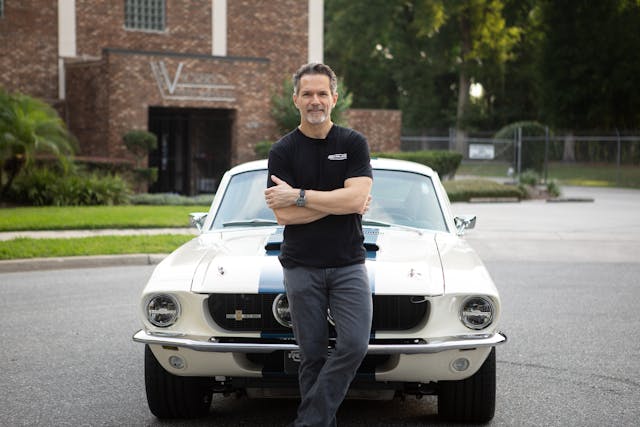
It seemed a bit unusual in 2015 for Ford to license a company to build one of its most iconic vintage cars, and losing that license is something Scarpello “kind of expected to happen at some point,” he told Hagerty.
“Having the license was kind of nice,” Scarpello said. “It was unique, it was something that helped set us apart, but is it really fundamental to differentiate us? I don’t think so. And it certainly hasn’t affected our demand or resale value. Maybe we’ve gotten to the point where our company can stand on its own when it comes to reputation, and maybe it really doesn’t add that much value anymore. So yeah, we’re fine.”
Originally, Revology began building Mustangs in a dark, cramped warehouse, with a crew of 11. Now Revology has a modern factory with, as of this month, 160 employees. In the past 10 years, the company has delivered more than 275 cars to owners in 20 countries.






So how does losing the license from Ford affect Revology’s day-to-day business? Not a lot, Scarpello said. “The bottom line for us is yes, we can still drag in donor cars and use them to basically build a restored Mustang from the donor—our process really doesn’t change.” Sometimes, he says, “the cars that we use for donors are effectively total wrecks. I mean, when the steel is rusted through, you have no choice but to replace the steel. You can put on an all-new body and effectively it’s the same thing.”
As for why Ford pulled that plug, Scarpello was told only that Ford reviewed the agreement, and decided that going forward, it wouldn’t license any road-going car that doesn’t comply with the National Highway Traffic Safety Administration regulations for new vehicles. It would be a massive and costly undertaking to make a car like a 1960s Mustang meet the current Federal Motor Vehicle Safety Standards—adding airbags and antilock brakes and other required features would require engineering capability that a company the size of Revology could never financially justify. Still, the new Revology Mustangs have a long list of safety features the originals didn’t have, including three-point front seat belts, a collapsible steering column, a fuel pump inertia switch, big dual-circuit disc brakes and external LED lighting. Brake lights, for example, are 10 times brighter than on the original car.
Some believe—though Scarpello himself is not so sure—that Ford’s review of its licensing practices may stem from a lawsuit that it filed last October against Vintage Bronco, which is now known as Vintage Modern. The Georgia company starts with a new Ford Bronco, removes the body, and replaces it with an aftermarket body that closely resembles the first-gen model but is longer, due to the 8.4-inch increase in wheelbase length. Safety features of the new vehicle are ostensibly retained, including six airbags and stability control.



The result, says Vintage Modern, is the “world’s first fully modernized classic car.” Despite Ford’s ongoing lawsuit, Vintage Modern appears to be in business, presently offering six available-now Broncos on its website, ranging from $275,800 to $290,450. Those Broncos aren’t, and never were, licensed by Ford.
When we reported on the case last November, Ford actively had two large law firms working on their side, first issuing a cease-and desist letter to Vintage Modern owner Chau Nguyen, following up with the lawsuit. When we spoke to Nguyen, he had no intention of folding his tent. “We’re not going anywhere,” Nguyen said. “Vintage Modern remains confident in the integrity of its practices and is 100 percent committed to providing the market with our modern classic vehicles. Vintage views this lawsuit as more than a legal battle—it is a challenge to innovation, consumer choice, and the aftermarket industry as a whole. We look forward to the opportunity to prove that Vintage operates with integrity and in full compliance with all applicable laws.”
Anyway, Scarpello’s lines of communication with Ford remain open. CEO Jim Farley is known to be a fan of Revology’s work, and at least three members of the Ford family have bought Revology Mustangs. Scarpello said that the only federal standard his company’s cars could conceivably fit are outlined in the Fixing America’s Surface Transportation, or FAST act, signed into law in 2015 by President Obama. Contained in that act is a provision that allows low-volume manufacturers, which means fewer than 5000 vehicles a year, to build or import up to 325 “replica” vintage vehicles annually.
“The only federal certification that exists that a car like this could possibly qualify for is in the FAST act,” Scarpello said. “And there’s a lot of implications involved for being able to meet the requirements of the FAST act, and it would involve Ford giving us access to proprietary technology. We’re having those discussions with them now.”

All that said, there have been some changes at Revology. While the company started out building reproduction 1965-66 Mustangs, it no longer does, now concentrating on 1967-68 models. As of this writing, the company’s website lists two 1966 Mustang convertibles for sale, for $293,670 and $294,670, and one 1966 Fastback for $295,545. All three are new builds, and all have the 5.0-liter Coyote Ford engine with 460 horsepower and a 10-speed automatic transmission. There’s also a “certified pre-owned” 1966 Mustang GT convertible for $150,470, and a ’66 Shelby GT convertible for $279,860.
And less than two weeks ago, the company announced that it will be building a brand-new (old) model, Revology’s take on the 1969 Ford Mustang Boss 429. The original Boss 429 was developed by Ford to homologate its new 429 cubic-inch (7.0-liter) V-8 engine for NASCAR. Fewer than 900 Boss 429 models were built, easily exceeding NASCAR’s 500-unit minimum.

The exterior design of the Revology Boss 429 is virtually identical to the original, with the most notable difference being the larger 17-inch wheels, needed to make room for the Wilwood disc brakes. Although the original Boss 429 was only offered with a manual transmission and without air conditioning, Revology buyers can choose between a six-speed manual and 10-speed automatic, and air conditioning is standard. Rather than a 429-cubic-inch V-8, Revology’s Boss 429 makes do with a Roush supercharged 5.0-liter Ford Coyote V-8, which pumps out 710 horsepower, 335 more than the original Boss motor.
Revology plans to build 15 Boss Mustangs this year, all of which have been spoken for by current customers. Next year, the company plans to build 50. The price hasn’t been set, but it will likely be north of $350,000. Scarpello is especially excited about his Boss’ interior, which is being overseen by a San Diego company headed by a former Nissan vice-president of design, Victor Nacif, aided by a former Audi interior designer “from the days when Audi interiors were the rage. Really top-notch design talent,” Scarpello said.

“The new car looks very much like a ’69 Boss 429 Mustang, but it’s just nicer, done to a higher level of craftsmanship. Kind of like if Bentley was to do a ’69 Mustang interior, that’s what it would look like. If I do say so myself.”
Last year, Jay Leno did a half-hour YouTube episode featuring Scarpello, who joined Leno on a brisk drive of a 1968 Revology Mustang Fastback, with the 710-horse engine. “Would you rather have this than a McLaren?” Jay Leno asked hypothetically, as the drive ended. “I think a lot of people might.”
Scarpello just sat in the passenger seat and smiled.





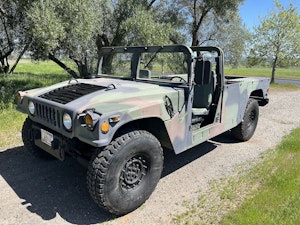
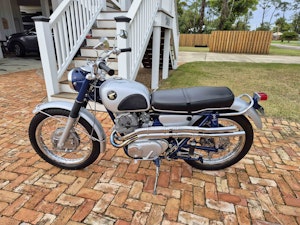
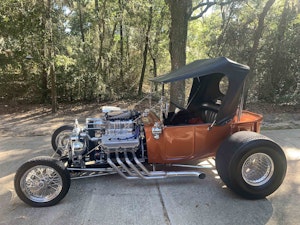




















The Boss 429 is all about the engine. Other than that there is little difference between it and a 69-70 Mustang sportsroof other than the hood scoop and decals. So why call it that especially when you/they can order up a Jon Kasse Boss 9? That is what I’d want/ expect to see under the hood of a modernized version advertising it. If they’re going this route and insist on using the ‘Boss’ designation why not Boss Coyote or better yet Boss Rev on the front fenders. That has a certain ring to it and it’s_ honest.
I would wonder considering the lost licensing agreement with Ford and the iconic nature of the real Boss 429 Mustang if anything “Boss” will be on the fender. There is serious value in the name and I’m not sure Ford will be pleased with anyone selling a Boss 429 that isn’t a Boss 429 in volume.
I would rather pay a little more for the genuine article. Why put 429 decals on a car that doesn’t even have a 302? These “high end” builds are way overpriced.
Well, maybe, but did you miss the part where I said they have already sold the first 15?
Dollar to a donut, those 15 were all sold to collectors and at $360k, you will never see them on the street. They should make adapters and bolt on Boss 429 valve covers, then they could, in very small script add, Valve Covers, under the Boss 429 stickers. But it could be worse, it could be electric.
Value is determined by the buyer … and not so much the seller. If you attended school anywhere in the world, you most probably took a course that explained ” supply and Demand “. Just because some individuals will not fork up the barrel of money does not mean that others will not. Beauty and Value is in the eye of the beholder.
I remember a very old joke about an indigent person sitting with a cup and asking people for $1000 so he could buy a cup of coffee. A passerby asked do you really think your going to get a bunch of people to give you $1000 for a cup of coffee … the response was I only need ONE. By the way, he enjoyed his cup of coffee at a Brazilian coffee plantation.
I have seen several of their cars in person and they are impressive combining the best of both worlds, nostalgia and modern performance. If I were an owner of 10 cars, with a couple million to spend, their car would be one of my 10. Just thankful to have my 2024 GT (over 800hp) and live in my price range ($60K).
The 69 Boss 429 is incredible. Just being able to purchase a modern adaptation of the original is wonderful, regardless of how many cubic inches are under the hood.
There was nothing special about the Boss 429 except the motor. Without the 429 you have a Sports Roof 302 Mustang with Boss 429 stickers. That is not incredible.
It would make more sense to me if there were a non-supercharged “Boss 302” and the supercharged version were called a “Boss 429”, even if it weren’t true it’d be in the spirit of the originals.
Honestly with all of the money in the world I’d take the normally aspirated one with a manual, set up for handling just as the original Boss 302 was. It’s my favorite Mustang of all time. For me 500ish hp in a road car is plenty, and I’d love the weight taken off of the nose.
I’ve been following Revology for a few years and love their cars….
This concept of old design and new tech is not new Billy Joel who is a motorcycle guy (I love bikes too but had to sell mine due to finance and space) does this with his bike shop called Century Cycle in Oyster Bay NY.
This is concept rocks as you get old world classic looks with new tech especially the more reliable, efficient engines. Growing up in the 70’s you would always see cars broken down on the side of the highways… which is a less of an occurrence now due better technology.
Also I have no nostalgia in someone’s old 69 (pun intended) Mustang with the old man stink and backseat Becky adventures, unless it was my own original.
I would rather have this new Revology Stang if I had a budget and stable for 10 cars… especially this vs the McLaren…which I have heard are prone to breaking down and in my opinion are more “Look at Me” cars for non-car people.
Revology should look into the Vintage Modern Concept- take the new Stang and put a old style (new) shell and perhaps re do the interior (cause new post 2015 stangs with all the screens just look terrible), this way they retain all the safety features e.g ABS, Airbags etc.
I hope Revology continues and who know if I ever with the Lotto in this lifetime I’ll definitely be a customer!
I am building a 2009 mustang black on black boss 429 theme mustang,already have the boss 429 scoop,came with a tremec 5 speed will I include the boss 429 graphic on the side of the front fender,I dought it,but something to think about,but I would agree maybe should have a 429 installed for the boss 429 graphic my guy has the 281 cid three valve, very fast as is!
Hey they had a window to do the builds with Ford’s blessing now they have to take an existing car. No different from any other restomod being done now.
Ford assistance would require numerous recalls. Better to stay away!
No that would be if it was a gm.
Restomodding of vintage 60’s muscle has found a permanent spot in the hobby, thanks to a growing demand from some folks with disposable income who want the vintage look with modern performance & reliability. It’s become so popular nowadays that an entire industry, with its own specialized manufacturers such as Revology, have sprung up. How long will it last? One has to give credit to Barrett-Jackson Scottsdale especially, for helping popularize it – but really, isn’t it just a modern take on hot rodding in general, with a larger budget?
There are many individuals and small shops that do this type of restoration, at half the price. And, why would anyone spend that much money on a factory built restomod when there are new vehicles that are cheaper, better and faster? A new ZO6 perhaps?
Which small shops you have had a look at ?
Why not use a supercharged 7.3 “Godzilla” on the Boss. At least displacement would be close. They might need a shoehorn, but that would show at least some effort to recreate the original.
My suggestion doesn’t hold much water since I’d need another couple of jobs to afford one. The 69 is my favorite though, boss or not!
Can I ask for Ford employee pricing to buy one?!
I’m kind of in agreement with Jay Leno (or at least what he has said numerous times) in that old cars really only appeal to me with minor modifications for safety only. If I wanted a new car with over-the-top horse power, screens in the dash and race car handling I would buy a new car like a Mustang GT. One of my previous cars was a 1964 Comet Caliente. Stock. If I owned it today I would add front disc brakes and a dual master cylinder. Maybe a hidden Secret Audio system as there are no AM band radio stations worth listening to any more. Back in the 80s when I drove my Comet there was a great AM station that played music from the 50s to the 70s and that was perfect for my old car. That’s about it. If I wanted faster today in the same I would find a nice Cyclone from the same era. I love old cars because they allow the driver to experience a different period in time and frankly I’m from that time and am not terribly fond of today’s rushed nanny state way of life.
I like what they do. But that Boss 429 is just plain dumb. I got really interested when it was mentioned, imagining a modern aluminium block version of the 429 hemi with modern fuel injection and other amazing things and — wow, what a let down.
**Agreed, what idiot puts a 302 in a remake of a BOSS 429 when the BOSS 302 was already a thing in the same body.
I think they should just put a 7 liter LS in it and call it a day.. that wouldn’t be any different in my opinion.
Just to add to my comment a few days ago… I’m a owner of a 2011 V8 Stang…and love the minimal interior vs the new ones with so much screen. I also like the more retro look of this 5th Gen Stang… wish Ford would make a 68-72 style Stangs… with the new engines and tech,,,but reduce the screens, just one centre screen like the one I have the 5th Gen is good enough, love my retro style gages vs the new LCD screens that replaced the analogue gages.